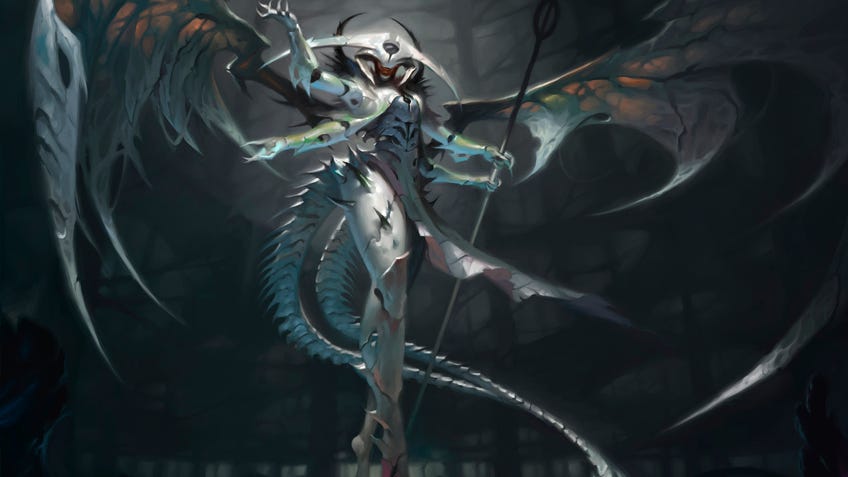Don’t be a bore in MTG Commander: build your next deck to win with weirdness
Winning with something unexpected is far more satisfying that just copying the latest meta.
With the release of Magic: The Gathering’s new fairy tale-themed standard set, Wilds of Eldraine, a new rogues’ gallery of legendary creatures have entered the fold, just waiting to head up your latest Commander deck. This set has a fair few options for Commander players, with some exceptionally powerful leaders available.
Hylda, of the Icy Crown has been a popular leader on MTG Arena with her ability to get extra value out of tapping your opponent’s creatures. Siblings Rowan and Will allow you to cheat out expensive spells when you lose or gain life respectively. I recently wrote about one of my favourites from the set, Imodane the Pyrohammer, who finally provides a really competitive option for a burn-based Commander.
But when searching for new options to lead your Commander deck, a pitfall players often fall into is grasping for whatever expensive, hyper-competitive and often ire-inducing legendary creature is currently sat atop EDHREC’s rankings. Most Commander players have heard the familiar groan when someone brings out an Atraxa, Jodah or Narset. All power level sevens, of course.
In my humble opinion, the most fun you can have building a Commander deck and then bringing it to the table is not through chasing the most highly-tuned and uber-powerful commanders, but instead finding the most oddly specific creatures to lead your 99. We’ve seen some really interesting creatures in Wilds of Eldraine that seem to mirror this philosophy; whilst their power levels can be debated, I’m most intrigued by how specific their abilities are.
The most fun you can have building a Commander deck is not through chasing the most highly-tuned and uber-powerful commanders, but instead finding the most oddly specific creatures to lead your 99.
Eriette of the Charmed Apple is a two colourless, one white and one black-mana legendary creature I’ve built recently that reads: “Each creature that's enchanted by an Aura you control can't attack you or planeswalkers you control. At the beginning of your end step, each opponent loses X life and you gain X life, where X is the number of Auras you control.” Immediately she’s built around a very specific game plan. Not just enchantment-focused, as quite a lot of Commander cards have been recently, but aura-focused instead.
She’s got a win condition stapled onto her rules text with her ability to drain your opponents of life - you just need to load her up with some good auras and you’re ready to roll. Yet, as with all deck-building, nothing is ever quite that simple. A good deck needs the ability to ramp, to draw cards, to protect itself and remove threats on the other sides of the table.

All of a sudden you start looking for ways to double-dip, finding removal spells that deal with enemy creatures that are also auras themselves - like swapping out the standard Banishing Light (a three-mana spell that exiles a target nonland permanent until it leaves the board) for a card like Ossification that does a similar job, but is also an aura that attaches itself to a basic land you control, giving you the removal you need while contributing to your main objective.
You might then realise that destroying or exiling a creature might not be as effective as attaching an aura to it that either supes it up and sends it in the direction of your opponents, with the aid of Eriette’s ability to stop creatures attacking you when enchanted by your auras or by using a card like Darksteel Mutation that turns it into a 0/1 indestructible bug with no abilities. (It gets funnier every time.)
You might even go down the route that I did when building Eriette, which is to pay little mind to what the rules text on your auras reads, instead only caring that they are cheap and draw you a card when you play them. It effectively allows me to play a fun little slot machine every time I play an aura for one mana - which then draws me an aura that I play for one mana, which then draws me an aura that I play for one mana…

Because Eriette wants you to be specific in the cards that you build her with, it forces you to think outside the box when you’re looking at what cards to bring into the fold. My favourite commanders of all time have been the ones that finally allow a place for all the weirdly specific bulk cards gathering dust in my collection. The ones that make me look at a card in a completely different light. That’s not to say that Eriette isn’t powerful or that she can’t win games. The point I’m trying to make here is that she forces you to approach the game, however slight, in a way that you may not have considered before.
My favourite commanders of all time have been the ones that finally allow a place for all the weirdly specific bulk cards gathering dust in my collection.
Let’s take a look at another commander in my collection. One that’s a little older, that might give a better example. Yedora, Grave Gardener is a four colourless and one green-mana legendary creature that reads: “Whenever another nontoken creature you control dies, you may return it to the battlefield face down under its owner's control. It's a Forest land.” There are currently only 2,274 decks with Yedora as the commander on EDHREC; in comparison, EDHREC has over 27,000 registered decks with Atraxa, Praetors' Voice at the helm alone.
On the face of things, Yedora seems like a relatively mundane ramping creature. If one of your creatures dies, you can stop it going to the graveyard in exchange for a free Forest. It’s a good ability, but as a mono-Green commander there’s not quite the amount of death-triggering you might be able to utilise as in, say, Black. That’s where one very weird and old mechanic comes in: Morph.
Originally landing in the Onslaught block, Morph is a keyword that allows you to play creatures facedown on the board as mysterious 2/2s with no rules text. It’s like a janky version of Foretell - or Yu-Gi-Oh!’s infamous trap cards. At instant speed you can pay its Morph cost to flip it up into its true form, and often you’ll get a triggered ability on that card that will pop off when it’s flipped face-up.
The weird thing about Morph cards is that they don’t really care how they were turned facedown. Which means that Yedora has the ability to infinitely flip dying Morph creatures back into their face-up state. Let’s combine that ability with a truly ugly creature that’s only in about 8,000 decks on EDHREC, Nantuko Vigilante.
Costing only about 35p as a single, Nantuko Vigilante is a 3/2 with a Morph cost of one colourless and one green mana and the text: “Whenever Nantuko Vigilante is turned face up, destroy target artifact or enchantment.” Wow, that’s not very good! But pop that down with a Yedora on the field with a sacrifice outlet on the side and you’ve got as much artifact and enchantment removal as you damn well please for just two mana a pop. Even less if you’re sacrificing your vigilante to an altar for mana. Not to mention, you can tap the land it turns into for more mana when it dies.

Finally this mediocre card has a home. And it’s all because we played this weird commander that no-one seems to like. Doesn’t that feel good? We can keep going. Pop a Quirion Ranger down for a single green mana that can untap a creature in return for returning a Forest you control to your hand. Now combo that with a Sakura Tribe Elder for some shenanigans.
Wins with weird Commanders just feel better.
Use Sakura Tribe Elder’s ability to sacrifice itself and put a basic land from your deck onto the battlefield. Yedora will turn him into a Forest, which you can tap for a green mana before using your Ranger to return the elder to your hand. Then play him again (with one of his two-mana cost already taken care of), use the ability again, and rinse and repeat until you’ve run out of mana. All of a sudden you’ve managed to cheat about five or six lands onto the battlefield from your deck. Good lord!
Yedora might not have the most powerful ability in the game, dozens of keywords and the ability to go infinite with half of the cards in the game. Eriette may be powerful, but she’ll never be putting out as much raw value as Atraxa, Praetor’s Voice - with its ability to proliferate at the end of each of your turns whilst also lifegaining, flying and being vigilant. But you also aren’t playing ridiculous combos with cards most people have never seen before when you pick those easy commanders.

Wins with weird Commanders just feel better. Playing a card and seeing every player around the table pause to look at it with sheer confusion will always be satisfying. Most importantly, you can find cards that seem to have been heaven-sent for your strange little deck that are so oddly specific to your commander they cost literal pennies to pick up.
So this is my call to you, dear reader, to play something weird and wonderful at your next Commander night. To play a commander no-one is running. I promise you’ll have far more fun with it than another joyless win using the most obvious cards in the format and a leader that has the rest of the table sighing before the game has even begun. Trust me.









